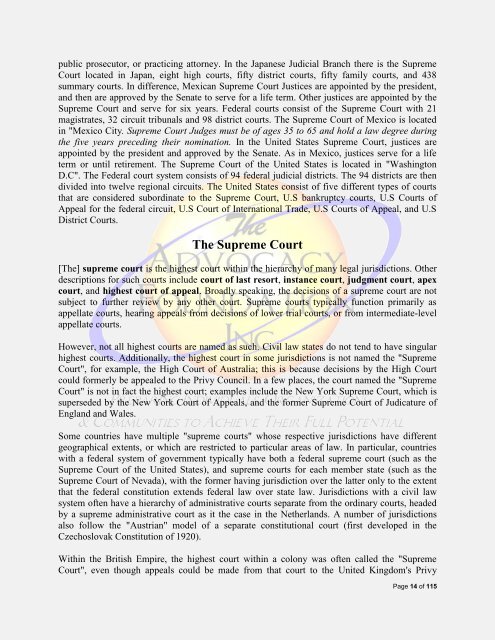Judicial ReEngineering
Judicial ReEngineering
Judicial ReEngineering
You also want an ePaper? Increase the reach of your titles
YUMPU automatically turns print PDFs into web optimized ePapers that Google loves.
public prosecutor, or practicing attorney. In the Japanese <strong>Judicial</strong> Branch there is the Supreme<br />
Court located in Japan, eight high courts, fifty district courts, fifty family courts, and 438<br />
summary courts. In difference, Mexican Supreme Court Justices are appointed by the president,<br />
and then are approved by the Senate to serve for a life term. Other justices are appointed by the<br />
Supreme Court and serve for six years. Federal courts consist of the Supreme Court with 21<br />
magistrates, 32 circuit tribunals and 98 district courts. The Supreme Court of Mexico is located<br />
in "Mexico City. Supreme Court Judges must be of ages 35 to 65 and hold a law degree during<br />
the five years preceding their nomination. In the United States Supreme Court, justices are<br />
appointed by the president and approved by the Senate. As in Mexico, justices serve for a life<br />
term or until retirement. The Supreme Court of the United States is located in "Washington<br />
D.C". The Federal court system consists of 94 federal judicial districts. The 94 districts are then<br />
divided into twelve regional circuits. The United States consist of five different types of courts<br />
that are considered subordinate to the Supreme Court, U.S bankruptcy courts, U.S Courts of<br />
Appeal for the federal circuit, U.S Court of International Trade, U.S Courts of Appeal, and U.S<br />
District Courts.<br />
The Supreme Court<br />
[The] supreme court is the highest court within the hierarchy of many legal jurisdictions. Other<br />
descriptions for such courts include court of last resort, instance court, judgment court, apex<br />
court, and highest court of appeal. Broadly speaking, the decisions of a supreme court are not<br />
subject to further review by any other court. Supreme courts typically function primarily as<br />
appellate courts, hearing appeals from decisions of lower trial courts, or from intermediate-level<br />
appellate courts.<br />
However, not all highest courts are named as such. Civil law states do not tend to have singular<br />
highest courts. Additionally, the highest court in some jurisdictions is not named the "Supreme<br />
Court", for example, the High Court of Australia; this is because decisions by the High Court<br />
could formerly be appealed to the Privy Council. In a few places, the court named the "Supreme<br />
Court" is not in fact the highest court; examples include the New York Supreme Court, which is<br />
superseded by the New York Court of Appeals, and the former Supreme Court of Judicature of<br />
England and Wales.<br />
Some countries have multiple "supreme courts" whose respective jurisdictions have different<br />
geographical extents, or which are restricted to particular areas of law. In particular, countries<br />
with a federal system of government typically have both a federal supreme court (such as the<br />
Supreme Court of the United States), and supreme courts for each member state (such as the<br />
Supreme Court of Nevada), with the former having jurisdiction over the latter only to the extent<br />
that the federal constitution extends federal law over state law. Jurisdictions with a civil law<br />
system often have a hierarchy of administrative courts separate from the ordinary courts, headed<br />
by a supreme administrative court as it the case in the Netherlands. A number of jurisdictions<br />
also follow the "Austrian" model of a separate constitutional court (first developed in the<br />
Czechoslovak Constitution of 1920).<br />
Within the British Empire, the highest court within a colony was often called the "Supreme<br />
Court", even though appeals could be made from that court to the United Kingdom's Privy<br />
Page 14 of 115

















